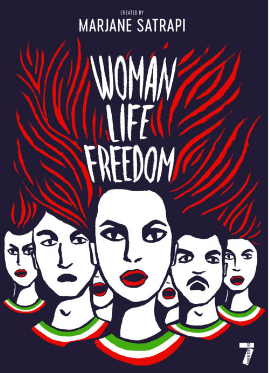Marjane Satrapi’s graphic memoirs, Persepolis and Persepolis II, as well as the Oscar-nominated film based on the original book, tell the story of the writer-illustrator’s coming-of-age in Iran in the 80s of the 20th century. Her new work focuses on the life of another young Iranian woman, 22-year-old Mahsa Amini, who was arrested, detained, and severely beaten in 2022 for some hair falling out of her hijab, and died in police custody. The movement’s slogan, “Women, Life, Freedom”, echoed around the world.
Shatabi’s new graphic anthology, Woman, Life, Freedom, tells the story of the eponymous movement through short graphic fragments. The project pairs artists with experts on Iran: Satrapi himself, two journalists, and an Iranian-born professor at Stanford University. The experts wrote text for each of the 23 vignettes divided into three sections detailing Amini’s death and aftermath, contextualizing events in light of the late 20th-century revolutions, and exploring everyday life in present-day Iran, where tensions increasingly reveal divisions between the ruling party and the people. The vignettes illustrate the complexity of interactions between residents: state-sanctioned violence, surveillance, and propaganda incite chaos and sow seeds of distrust among neighbors. Dominant culture is a culture of fear.

Some of the illustrations in Woman, Life, Freedom read like political cartoons, while others provide intimate scenes of everyday life. These styles reflect the personality of the creator – swooping, impressionist, monochrome and frameless illustrations coexist with framed, sequential, multicolor illustrations. In all cases, visual media enhances storytelling and creates an immersive reading experience that can easily convey information. In my favorite vignettes, such as “In the Diaspora Hearts,” I feel like I’m eavesdropping on conversations that are both familiar and extremely complex, just as I felt when I read Persepolis.
Shatabi’s memoirs have been widely praised for creating complex images of Iran that explore the subjective daily experiences of the people who live there. She brings the ability to connect with her readers here as well. In the preface, she writes that the purpose of the book is to “remind Iranians that they are not alone.” The anthology is being published in several languages, distributed around the world, and is freely available online in Persian to Iranian readers. “Women, Life, Liberty” tells the story of the human toll of the dictatorship and the heroic resistance movement that the people are underway.